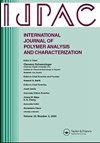通过响应面方法优化丝兰纤维基接枝共聚物并评估其物理化学性能
IF 1.6
4区 工程技术
Q4 POLYMER SCIENCE
International Journal of Polymer Analysis and Characterization
Pub Date : 2024-10-02
DOI:10.1080/1023666X.2024.2377645
引用次数: 0
摘要
以硫酸亚铁铵-过硫酸钾为重做剂,通过与甲基丙烯酸乙酯的接枝共聚对丝兰(Yucca filamentosa,Yf)天然纤维进行物理化学改性的研究...本文章由计算机程序翻译,如有差异,请以英文原文为准。
Optimization of Yucca filamentosa fiber based graft copolymer through response surface methodology and evaluation of physico-chemical properties
The study of the physico-chemical modification of Yucca filamentosa (Yf) natural fiber by graft copolymerization with ethylmethacrylate using ferrous ammonium sulfate-potassium persulfate as a redox initiator has been reported in the article. Initially, six process parameters; reaction duration, reaction temperature, solvent amount, pH, FAS:KPS ratio, and monomer concentration were used in the study in a sequential experimental design technique, and the significant process variables affecting the yield of the graft copolymer were identified. The Resolution-V design method identified the significant parameters as the reaction temperature, amount of solvent, and the concentration of monomer. In second phase of the study, the screened variables were utilized in the development of a model through the technique of response surface methodology (RSM) for the prediction of the yields, and its optimization. The developed RSM model fitted well with the experimental data, and predicted for the optimal conditions of reactions as temperature 50 °C, solvent 100 ml, and the monomer 3.05 × 10−3 mol/L; at which the highest graft yield percentage obtained was 124.2%. The techniques of FTIR, SEM, and XRD were used for the characterization graft copolymers. Studies of the various physico-chemical properties showed that the produced graft copolymers were more resistant than the natural fibers.
求助全文
通过发布文献求助,成功后即可免费获取论文全文。
去求助
来源期刊
CiteScore
3.50
自引率
5.30%
发文量
37
审稿时长
1.6 months
期刊介绍:
The scope of the journal is to publish original contributions and reviews on studies, methodologies, instrumentation, and applications involving the analysis and characterization of polymers and polymeric-based materials, including synthetic polymers, blends, composites, fibers, coatings, supramolecular structures, polysaccharides, and biopolymers. The Journal will accept papers and review articles on the following topics and research areas involving fundamental and applied studies of polymer analysis and characterization:
Characterization and analysis of new and existing polymers and polymeric-based materials.
Design and evaluation of analytical instrumentation and physical testing equipment.
Determination of molecular weight, size, conformation, branching, cross-linking, chemical structure, and sequence distribution.
Using separation, spectroscopic, and scattering techniques.
Surface characterization of polymeric materials.
Measurement of solution and bulk properties and behavior of polymers.
Studies involving structure-property-processing relationships, and polymer aging.
Analysis of oligomeric materials.
Analysis of polymer additives and decomposition products.

 求助内容:
求助内容: 应助结果提醒方式:
应助结果提醒方式:


